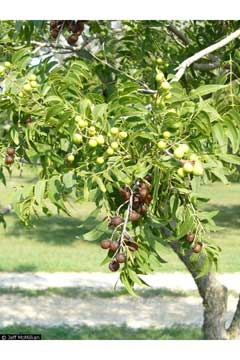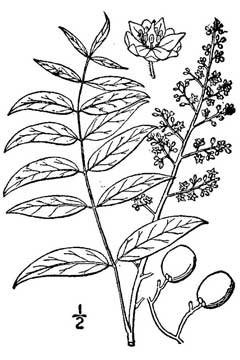 |
|
Jeff McMillian @ USDA-NRCS PLANTS Database |
 |
| USDA-NRCS PLANTS Database / Britton, N.L., and A. Brown. 1913. An illustrated flora of the northern United States, Canada and the British Possessions. 3 vols. Charles Scribner's Sons, New York. Vol. 2 |
Translate this page:
Summary
Physical Characteristics

 Sapindus drummondii is a deciduous Tree growing to 12 m (39ft 4in) at a slow rate.
Sapindus drummondii is a deciduous Tree growing to 12 m (39ft 4in) at a slow rate.
See above for USDA hardiness. It is hardy to UK zone 8. It is in leaf from April to October, in flower from May to June, and the seeds ripen in November. The species is monoecious (individual flowers are either male or female, but both sexes can be found on the same plant).
Suitable for: light (sandy), medium (loamy) and heavy (clay) soils, prefers well-drained soil and can grow in nutritionally poor soil. Suitable pH: mildly acid, neutral and basic (mildly alkaline) soils. It cannot grow in the shade. It prefers dry or moist soil and can tolerate drought.
UK Hardiness Map
US Hardiness Map
Synonyms
S. saponaria drummondii. (Hook.&Arn.)L.Benson.
Plant Habitats
Woodland Garden Secondary; Sunny Edge;
Edible Uses
Edible Parts: Fruit
Edible Uses:
Fruit[105]. No more details from this report but another report says that it is poisonous[149]. The berry-like fruits have a leathery coat that contains poisonous saponins[229]. The fruit is about 15mm in diameter[200] and often hangs on the tree until the following spring[82].
References More on Edible Uses
Medicinal Uses
Plants For A Future can not take any responsibility for any adverse effects from the use of plants. Always seek advice from a professional before using a plant medicinally.
Antirheumatic Febrifuge Kidney Poultice
The fruit is antirheumatic and febrifuge[149]. It is used in the treatment of kidney diseases[149, 227]. A poultice of the sap has been used to treat wounds[257].
References More on Medicinal Uses
The Bookshop: Edible Plant Books
Our Latest books on Perennial Plants For Food Forests and Permaculture Gardens in paperback or digital formats.

Edible Tropical Plants
Food Forest Plants for Hotter Conditions: 250+ Plants For Tropical Food Forests & Permaculture Gardens.
More

Edible Temperate Plants
Plants for Your Food Forest: 500 Plants for Temperate Food Forests & Permaculture Gardens.
More

More Books
PFAF have eight books available in paperback and digital formats. Browse the shop for more information.
Shop Now
Other Uses
Buttons Soap Wood
A soap is obtained from the fruit by rubbing the fruit in water[1, 11, 95, 103]. Used in Mexico for washing clothes[227]. The fruit can be dried and stored for later use[169]. Buttons and necklaces are made from the seed[149]. Wood - heavy, strong and close-grained[82, 149]. It weighs 51lb per cubic foot[227]. It splits easily into thin strips and is often used in basket making, it is also used as a fuel[61, 82, 227, 229].
Special Uses
References More on Other Uses
Cultivation details
Succeeds in any well-drained soil in full sun[220]. This species tolerates a wide range of soils, including those that are dry, stony and nutrient deficient[200]. One report says that this species will probably not survive long outdoors in Britain, even though it is the hardiest member of the genus[1]. Another says that it is quite hardy in Britain[11] whilst a third says that it can tolerate temperatures down to about -7°c[200]. A specimen planted at Kew in 1987 was 2½ metres tall and looking very healthy in August 1999[K]. Trees are relatively slow-growing in the wild[229].
References Carbon Farming Information and Carbon Sequestration Information
Temperature Converter
Type a value in the Celsius field to convert the value to Fahrenheit:
Fahrenheit:
The PFAF Bookshop
Plants For A Future have a number of books available in paperback and digital form. Book titles include Edible Plants, Edible Perennials, Edible Trees,Edible Shrubs, Woodland Gardening, and Temperate Food Forest Plants. Our new book is Food Forest Plants For Hotter Conditions (Tropical and Sub-Tropical).
Shop Now
Plant Propagation
Seed - requires some cold stratification. Pre-soak the seed for 24 hours in warm water and sow in a cold frame in mid-winter. Move to a greenhouse in early spring. The seed should germinate in late spring. Prick out the seedlings into individual pots when they are large enough to handle and grow them on in the greenhouse for at least their first winter. Plant out in early summer. Cuttings of almost ripe wood, 5 - 8cm with a heel, July/August in a frame. Fairly good percentage[78].
Other Names
If available other names are mentioned here
Native Range
NORTHERN AMERICA: United States (Kansas, Missouri, Colorado, Louisiana, New Mexico, Texas, Arizona), Mexico
Weed Potential
Right plant wrong place. We are currently updating this section.
Please note that a plant may be invasive in one area but may not in your area so it's worth checking.
Conservation Status
IUCN Red List of Threatened Plants Status :

Growth: S = slow M = medium F = fast. Soil: L = light (sandy) M = medium H = heavy (clay). pH: A = acid N = neutral B = basic (alkaline). Shade: F = full shade S = semi-shade N = no shade. Moisture: D = dry M = Moist We = wet Wa = water.
Now available:
Food Forest Plants for Mediterranean Conditions
350+ Perennial Plants For Mediterranean and Drier Food Forests and Permaculture Gardens.
[Paperback and eBook]
This is the third in Plants For A Future's series of plant guides for food forests tailored to
specific climate zones. Following volumes on temperate and tropical ecosystems, this book focuses
on species suited to Mediterranean conditions—regions with hot, dry summers and cool, wet winters,
often facing the added challenge of climate change.
Read More
Expert comment
Author
Hook.&Arn.
Botanical References
1143200
Links / References
For a list of references used on this page please go here
Readers comment
| Add a comment |
|
If you have important information about this plant that may help other users please add a comment or link below. Only comments or links that are felt to be directly relevant to a plant will be included. If you think a comment/link or information contained on this page is inaccurate or misleading we would welcome your feedback at [email protected]. If you have questions about a plant please use the Forum on this website as we do not have the resources to answer questions ourselves.
* Please note: the comments by website users are not necessarily those held by PFAF and may give misleading or inaccurate information.
To leave a comment please Register or login here All comments need to be approved so will not appear immediately.
|
Subject : Sapindus drummondii
|
|
|
|